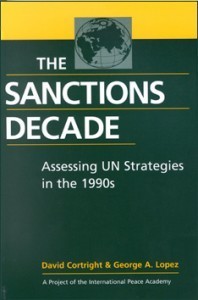
(Lynne Rienner, 2000) By David Cortright and George A. Lopez.
Since the end of the Cold War, economic sanctions have been a frequent instrument of UN authority, imposed by the Security Council against nearly a dozen targets. Some efforts appear to have been successful, others are more doubtful; all, though, have been controversial. This book is based on more than two hundred interviews with sanctions experts and officials from the UN and many countries. It provides the first comprehensive assessment of the effectiveness of UN sanctions during the 1990s.
The authors develop a set of criteria for judging the full impact of sanctions—political, economic, and humanitarian—and then provide detailed studies of eleven cases. They conclude with far-reaching recommendations for increasing the viability of sanctions as a productive diplomatic tool.
“This book is a key reference on an essential topic.” - Journal of Peace Research
“Perhaps most importantly, the work of Cortright and Lopez allows the reader to better understand what does, rather than what does not, lead to the implementation of a successful sanctions regime.”- Michael H. Carriere, International Affairs
“Given that the superiority of multilateral measures has become something of a mantra in the sanctions debate, a book subjecting UN sanctions to the same rigorous analysis that unilateral ones have undergone is long overdue. With their new book, The Sanctions Decade, David Cortright and George Lopez fill this gap.” - Meghan L. O’Sullivan, Survival
Winner of the Choice Outstanding Book Award:
“Does the world really need another book on this topic? The somewhat surprising answer to this question is yes—if the book in question is The Sanctions Decade by Cortright and Lopez …. An excellent and needed addition to the sanctions literature.” - Choice
This work was produced in part through the generous financial contribution of the United States Institute of Peace. The opinions, findings and conclusions or recommendations expressed in this publication are those of the author(s) and do not necessarily reflect the views of the United States Institute of Peace.